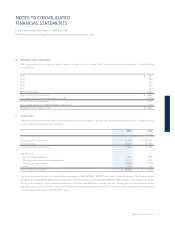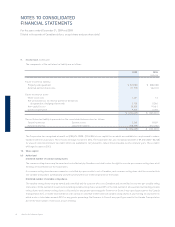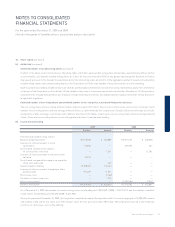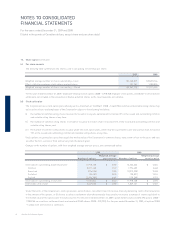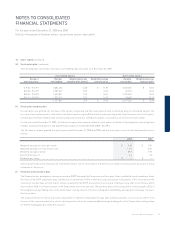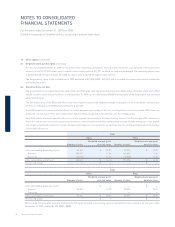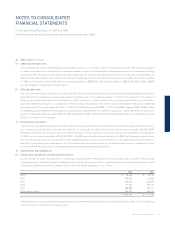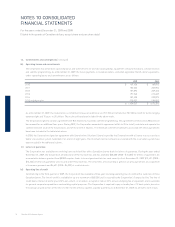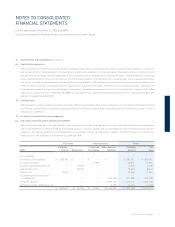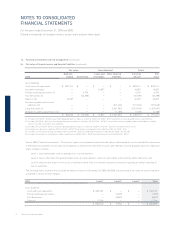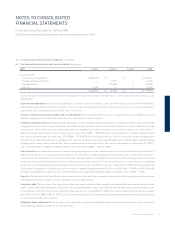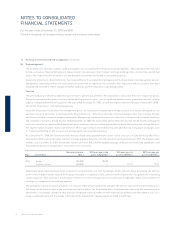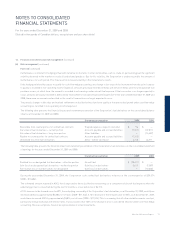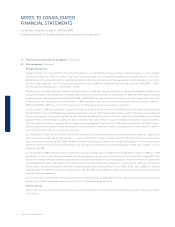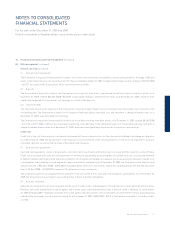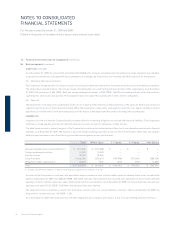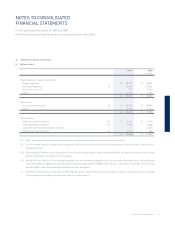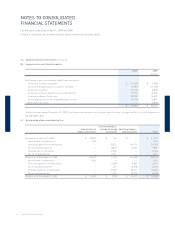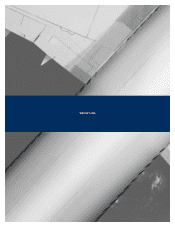Westjet 2009 Annual Report Download - page 103
Download and view the complete annual report
Please find page 103 of the 2009 Westjet annual report below. You can navigate through the pages in the report by either clicking on the pages listed below, or by using the keyword search tool below to find specific information within the annual report.
WestJet 2009 Annual Report 73
NOTES TO CONSOLIDATED
FINANCIAL STATEMENTS
For the years ended December 31, 2009 and 2008
(Stated in thousands of Canadian dollars, except share and per share data)
13. Financial instruments and risk management (continued)
(a) Fair value of fi nancial assets and fi nancial liabilities (continued)
During the years ended December 31, 2009 and 2008, there were no transfers between level 1, level 2 and level 3 classified assets
and liabilities.
Cash and cash equivalents: Cash and cash equivalents, classifi ed as level 1 instruments, consist of bank balances and short-term investments,
primarily highly liquid debt instruments, with terms of up to one year with the majority less than 91 days. The fair value of cash and cash equivalents
approximates their carrying values due to their short-term nature.
Accounts receivable and accounts payable and accrued liabilities: The carrying amount of accounts receivable and accounts payable and accrued
liabilities approximates their fair values due to the short-term nature of the instruments.
Foreign exchange derivatives: Foreign exchange derivatives consist of forward contracts and option arrangements. The fair value of the foreign
exchange forward contracts is measured based on the difference between the contracted rate and the current forward price obtained from the
counterparty, which can be observed and corroborated in the marketplace. These instruments are classifi ed as level 2. As at December 31,
2009, the average contracted rate on the forward contracts was 1.0671 (2008 – 1.0519) US dollars to Canadian dollars, and the average forward
rate used in determining the fair value was 1.0512 (2008 – 1.2178) US dollars to Canadian dollars. The fair value of the foreign exchange option
arrangements is determined through a standard option valuation technique used by the counterparty based on market inputs, including foreign
exchange rates, interest rates and volatilities. These instruments are classifi ed as level 2. The contract outstanding as at December 31, 2009, is
at a contracted range of 1.0800 to 1.1500 US dollars to Canadian dollars (2008 – 1.1333 to 1.2254).
Fuel derivatives: Fuel derivatives consist of fi xed swap agreements and costless collar structures. The fair value of the fuel derivatives is
determined using inputs, including quoted forward prices for commodities, foreign exchange rates and interest rates, which can be observed or
corroborated in the marketplace. The fair value of the fi xed swap agreements is estimated by discounting the difference between the contractual
strike price and the current forward price. These instruments are classifi ed as level 2. The fair value of the costless collar structures is estimated
by the use of a standard option valuation technique. These instruments are classifi ed as level 2. As at December 31, 2009, for the period that the
Corporation is hedged, the closing forward curve for crude oil ranged from approximately US $79 to US $84 (2008 – US $45 to US $67) with the
average forward foreign exchange rate used in determining the fair value being 1.0536 US dollars to Canadian dollars (2008 – 1.2136).
Deposits: The fair value of the deposits that relate to purchased aircraft and airport operations approximates their carrying amounts as they are
at a fl oating market rate of interest. These instruments are classifi ed as level 1.
Long-term debt: The fair value of the Corporation’s fi xed-rate long-term debt is determined by discounting the future contractual cash fl ows
under current fi nancing arrangements at discount rates obtained from the lender, which represent borrowing rates presently available to the
Corporation for loans with similar terms and remaining maturities. As at December 31, 2009, rates used in determining the fair value ranged
from 2.28% to 3.27% (2008 – 2.08% to 2.58%). The fair value of the Corporation’s variable-rate long-term debt approximates its carrying value, as
it is at a fl oating market rate of interest.
Obligations under capital leases: The fair value of the Corporation’s capital lease obligations approximates their carrying value due to their short-
term remaining maturities or their recent inception date.
2008 Level 1 Level 2 Level 3 Total
Asset (liability):
Cash and cash equivalents $ 820,214 $ — $ — $ 820,214
Foreign exchange derivatives — 6,735 — 6,735
Fuel derivatives — (52,298) — (52,298)
Deposits 24,309 — — 24,309
$ 844,523 $ (45,563) $ — $ 798,960


